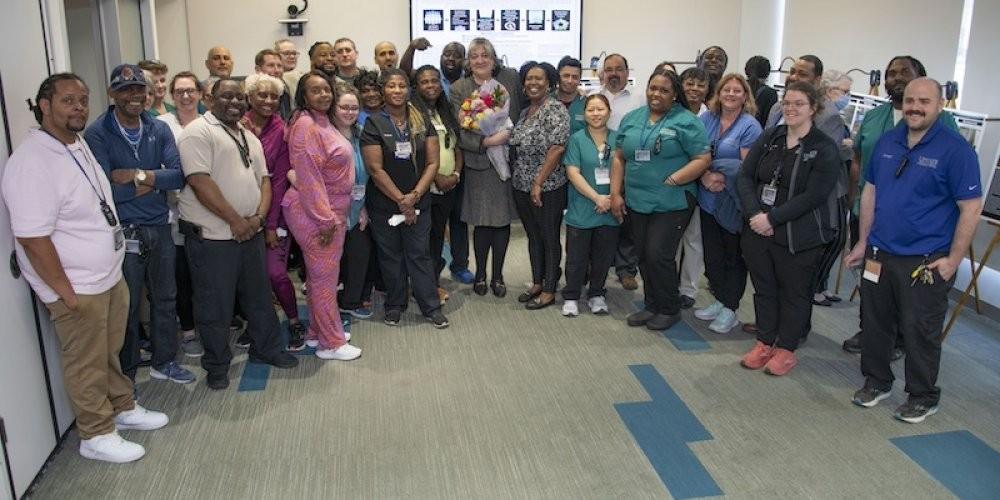Public Health class Photovoice project helps tell story of Environmental Services employees
Leaders at Upstate Medical University got a glimpse into the lives of Upstate’s environmental service workers, told through photographs and words, at a recent Photovoice display, held at the Upstate Cancer Center.
Photovoice is an evidence-based qualitative methodology and community-based tool that allows people to use photographs to represent their lived experiences. The Upstate Public Health faculty and Environmental Service leadership team used this as a quality improvement project to improve the lived experiences of environmental service workers at Upstate Medical University.
Ten participants from the department were matched with six students in Advanced Qualitative Methods, taught by Telisa Stewart, DrPH, and Scott Rosas, PhD. The participants were given cameras to document three experiences from their work; when they felt proud, when they felt connected to the clinical community and when they felt disconnected from it. Employees took dozens of photos for each prompt and then chose which one represented each experience the best. After, they reflected on each photo through prompts provided by the students to create a vignette to accompany each photo.
“Through the images and the vignettes, you get to see the lived experiences of these Environmental Service workers like you’ve never seen it before,” Stewart said. “The pictures and vignettes allow decision makers to get to know the workers, understand the system challenges, and celebrate successes. Photovoice is a powerful empowerment tool.”
Susan Murphy, director of Environmental Services and Linen, said there are 300 workers in her department, many of whom speak English as a second language. They are tasked with not only keeping up with a variety of viruses, bacteria and super bugs and but also understand how to clean and prevent spread.
“Cleaning isn’t simply wiping a surface and calling it a day,” she said. “Environmental Service workers understand the keys are people, product and process. That time, temperature, product and process are the key to a safe environment.”
She said, in University Hospital alone, they pull 150,000 pounds of trash a month. EVS workers pull trash and linen from patient care areas two to three times a day. Their work is crucial to critical care at the hospitals.
“We all have the same goal,” Murphy said. “We’re here to bring about the best hospital outcomes for the patients, keeping in mind EVS workers are the frontline for infection prevention.”
Murphy said she and her team were thrilled about this project giving these workers a voice.
“The team gained a new understanding of a different way to help improve quality, ways they can help make change, gained more confidence to speak up and feel more appreciated,” she said. “They were thankful to be a part of new quality initiative. They are hopeful this makes a difference and are thrilled that they have the ability to make change for the better.”
The students and the workers met each week over Zoom. After some brief photography lessons and discussion of the topics, the workers took pictures about how they feel proud, connected and disconnected to the clinical community. That dialogue helped the workers feel more connected to each other as they shared common experiences.
“Pictures are a powerful tool—as pictures speak a 1,000 words,” Stewart said. “The workers were deeply invested in sharing their lived experiences with the Upstate community, in hopes of bringing awareness.”
Three environmental service team members, Moustapha Salawu, Sherry Jones and Michelle Robinson agreed that they enjoyed the experience and are thankful for the opportunity to express themselves and to educate others on the work they do.
“I felt good about sharing a part of me and my story,” said Jones, who has worked at Upstate for 21 years.
“The project gave us a voice to explain our day to day duties, the good, the bad and ugly,” Robinson said. “Plenty of people overlook EVS and like lots of us say, ‘there's not many that can handle what we go through on a daily basis.’ I hope this project can open minds to how important our jobs are at the hospital. “
The project culminated with the viewing of the photos and vignettes when decision makers and managers throughout the institution were asked to come to better understand workers lives.
“The photographs allowed workers to be their own best advocate,” Stewart said. “The community event was power because it brought together workers and decision makers to discuss change and celebrate success. The leadership now have information to make positive change.”
Dozens of Environmental Services employees joined Upstate officers and others at the Photovoice display, which featured 10 easels each displaying three photos and corresponding written vignettes by the EVS employees.
Upstate President Mantosh Dewan, MD, and Chief Medical Officer Amy Tucker, MD, were among the leaders viewing the Photovoice display. They were moved by the images that told of how EVS workers felt proud, connected and disconnected from the Upstate clinical teams and vowed to ensure that EVS workers are recognized more often for their pivotal work at Upstate.
"We value you and greatly appreciate the work you do everyday,” Dewan said. “This event today will be the first of many where we will celebrate our EVS team members.”
Caption: Environmental Service (EVS) team members and EVS Director Susan Murphy, with flowers.

